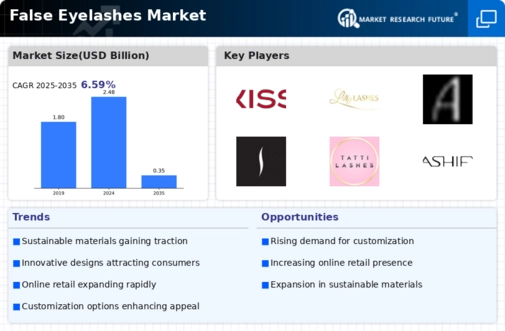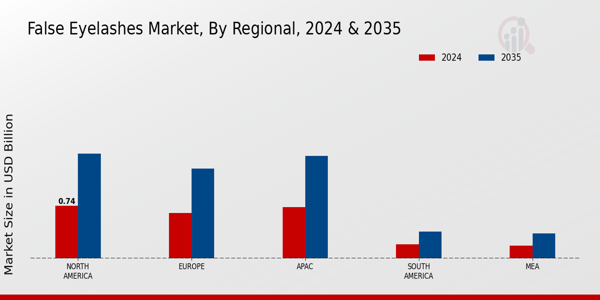- False Eyelashes Market By Type (USD Billion, 2019-2035)
- Strip Lashes
- Individual Lashes
- Magnetic Lashes
- Self-Adhesive Lashes
- False Eyelashes Market By Material (USD Billion, 2019-2035)
- Synthetic Hair
- Natural Hair
- Silk
- Mink
- False Eyelashes Market By Application (USD Billion, 2019-2035)
- Personal Use
- Professional Use
- Cosmetic Industry
- False Eyelashes Market By Length (USD Billion, 2019-2035)
- Short
- Medium
- Long
- Extra Long
- False Eyelashes Market By Regional (USD Billion, 2019-2035)
- North America
- Europe
- South America
- Asia Pacific
- Middle East and Africa
North America Outlook (USD Billion, 2019-2035)
North America False Eyelashes Market by Type
Strip Lashes
Individual Lashes
Magnetic Lashes
Self-Adhesive Lashes
North America False Eyelashes Market by Material Type
Synthetic Hair
Natural Hair
Silk
Mink
North America False Eyelashes Market by Application Type
Personal Use
Professional Use
Cosmetic Industry
North America False Eyelashes Market by Length Type
Short
Medium
Long
Extra Long
North America False Eyelashes Market by Regional Type
US
Canada
US Outlook (USD Billion, 2019-2035)
US False Eyelashes Market by Type
Strip Lashes
Individual Lashes
Magnetic Lashes
Self-Adhesive Lashes
US False Eyelashes Market by Material Type
Synthetic Hair
Natural Hair
Silk
Mink
US False Eyelashes Market by Application Type
Personal Use
Professional Use
Cosmetic Industry
US False Eyelashes Market by Length Type
Short
Medium
Long
Extra Long
CANADA Outlook (USD Billion, 2019-2035)
CANADA False Eyelashes Market by Type
Strip Lashes
Individual Lashes
Magnetic Lashes
Self-Adhesive Lashes
CANADA False Eyelashes Market by Material Type
Synthetic Hair
Natural Hair
Silk
Mink
CANADA False Eyelashes Market by Application Type
Personal Use
Professional Use
Cosmetic Industry
CANADA False Eyelashes Market by Length Type
Short
Medium
Long
Extra Long
Europe Outlook (USD Billion, 2019-2035)
Europe False Eyelashes Market by Type
Strip Lashes
Individual Lashes
Magnetic Lashes
Self-Adhesive Lashes
Europe False Eyelashes Market by Material Type
Synthetic Hair
Natural Hair
Silk
Mink
Europe False Eyelashes Market by Application Type
Personal Use
Professional Use
Cosmetic Industry
Europe False Eyelashes Market by Length Type
Short
Medium
Long
Extra Long
Europe False Eyelashes Market by Regional Type
Germany
UK
France
Russia
Italy
Spain
Rest of Europe
GERMANY Outlook (USD Billion, 2019-2035)
GERMANY False Eyelashes Market by Type
Strip Lashes
Individual Lashes
Magnetic Lashes
Self-Adhesive Lashes
GERMANY False Eyelashes Market by Material Type
Synthetic Hair
Natural Hair
Silk
Mink
GERMANY False Eyelashes Market by Application Type
Personal Use
Professional Use
Cosmetic Industry
GERMANY False Eyelashes Market by Length Type
Short
Medium
Long
Extra Long
UK Outlook (USD Billion, 2019-2035)
UK False Eyelashes Market by Type
Strip Lashes
Individual Lashes
Magnetic Lashes
Self-Adhesive Lashes
UK False Eyelashes Market by Material Type
Synthetic Hair
Natural Hair
Silk
Mink
UK False Eyelashes Market by Application Type
Personal Use
Professional Use
Cosmetic Industry
UK False Eyelashes Market by Length Type
Short
Medium
Long
Extra Long
FRANCE Outlook (USD Billion, 2019-2035)
FRANCE False Eyelashes Market by Type
Strip Lashes
Individual Lashes
Magnetic Lashes
Self-Adhesive Lashes
FRANCE False Eyelashes Market by Material Type
Synthetic Hair
Natural Hair
Silk
Mink
FRANCE False Eyelashes Market by Application Type
Personal Use
Professional Use
Cosmetic Industry
FRANCE False Eyelashes Market by Length Type
Short
Medium
Long
Extra Long
RUSSIA Outlook (USD Billion, 2019-2035)
RUSSIA False Eyelashes Market by Type
Strip Lashes
Individual Lashes
Magnetic Lashes
Self-Adhesive Lashes
RUSSIA False Eyelashes Market by Material Type
Synthetic Hair
Natural Hair
Silk
Mink
RUSSIA False Eyelashes Market by Application Type
Personal Use
Professional Use
Cosmetic Industry
RUSSIA False Eyelashes Market by Length Type
Short
Medium
Long
Extra Long
ITALY Outlook (USD Billion, 2019-2035)
ITALY False Eyelashes Market by Type
Strip Lashes
Individual Lashes
Magnetic Lashes
Self-Adhesive Lashes
ITALY False Eyelashes Market by Material Type
Synthetic Hair
Natural Hair
Silk
Mink
ITALY False Eyelashes Market by Application Type
Personal Use
Professional Use
Cosmetic Industry
ITALY False Eyelashes Market by Length Type
Short
Medium
Long
Extra Long
SPAIN Outlook (USD Billion, 2019-2035)
SPAIN False Eyelashes Market by Type
Strip Lashes
Individual Lashes
Magnetic Lashes
Self-Adhesive Lashes
SPAIN False Eyelashes Market by Material Type
Synthetic Hair
Natural Hair
Silk
Mink
SPAIN False Eyelashes Market by Application Type
Personal Use
Professional Use
Cosmetic Industry
SPAIN False Eyelashes Market by Length Type
Short
Medium
Long
Extra Long
REST OF EUROPE Outlook (USD Billion, 2019-2035)
REST OF EUROPE False Eyelashes Market by Type
Strip Lashes
Individual Lashes
Magnetic Lashes
Self-Adhesive Lashes
REST OF EUROPE False Eyelashes Market by Material Type
Synthetic Hair
Natural Hair
Silk
Mink
REST OF EUROPE False Eyelashes Market by Application Type
Personal Use
Professional Use
Cosmetic Industry
REST OF EUROPE False Eyelashes Market by Length Type
Short
Medium
Long
Extra Long
APAC Outlook (USD Billion, 2019-2035)
APAC False Eyelashes Market by Type
Strip Lashes
Individual Lashes
Magnetic Lashes
Self-Adhesive Lashes
APAC False Eyelashes Market by Material Type
Synthetic Hair
Natural Hair
Silk
Mink
APAC False Eyelashes Market by Application Type
Personal Use
Professional Use
Cosmetic Industry
APAC False Eyelashes Market by Length Type
Short
Medium
Long
Extra Long
APAC False Eyelashes Market by Regional Type
China
India
Japan
South Korea
Malaysia
Thailand
Indonesia
Rest of APAC
CHINA Outlook (USD Billion, 2019-2035)
CHINA False Eyelashes Market by Type
Strip Lashes
Individual Lashes
Magnetic Lashes
Self-Adhesive Lashes
CHINA False Eyelashes Market by Material Type
Synthetic Hair
Natural Hair
Silk
Mink
CHINA False Eyelashes Market by Application Type
Personal Use
Professional Use
Cosmetic Industry
CHINA False Eyelashes Market by Length Type
Short
Medium
Long
Extra Long
INDIA Outlook (USD Billion, 2019-2035)
INDIA False Eyelashes Market by Type
Strip Lashes
Individual Lashes
Magnetic Lashes
Self-Adhesive Lashes
INDIA False Eyelashes Market by Material Type
Synthetic Hair
Natural Hair
Silk
Mink
INDIA False Eyelashes Market by Application Type
Personal Use
Professional Use
Cosmetic Industry
INDIA False Eyelashes Market by Length Type
Short
Medium
Long
Extra Long
JAPAN Outlook (USD Billion, 2019-2035)
JAPAN False Eyelashes Market by Type
Strip Lashes
Individual Lashes
Magnetic Lashes
Self-Adhesive Lashes
JAPAN False Eyelashes Market by Material Type
Synthetic Hair
Natural Hair
Silk
Mink
JAPAN False Eyelashes Market by Application Type
Personal Use
Professional Use
Cosmetic Industry
JAPAN False Eyelashes Market by Length Type
Short
Medium
Long
Extra Long
SOUTH KOREA Outlook (USD Billion, 2019-2035)
SOUTH KOREA False Eyelashes Market by Type
Strip Lashes
Individual Lashes
Magnetic Lashes
Self-Adhesive Lashes
SOUTH KOREA False Eyelashes Market by Material Type
Synthetic Hair
Natural Hair
Silk
Mink
SOUTH KOREA False Eyelashes Market by Application Type
Personal Use
Professional Use
Cosmetic Industry
SOUTH KOREA False Eyelashes Market by Length Type
Short
Medium
Long
Extra Long
MALAYSIA Outlook (USD Billion, 2019-2035)
MALAYSIA False Eyelashes Market by Type
Strip Lashes
Individual Lashes
Magnetic Lashes
Self-Adhesive Lashes
MALAYSIA False Eyelashes Market by Material Type
Synthetic Hair
Natural Hair
Silk
Mink
MALAYSIA False Eyelashes Market by Application Type
Personal Use
Professional Use
Cosmetic Industry
MALAYSIA False Eyelashes Market by Length Type
Short
Medium
Long
Extra Long
THAILAND Outlook (USD Billion, 2019-2035)
THAILAND False Eyelashes Market by Type
Strip Lashes
Individual Lashes
Magnetic Lashes
Self-Adhesive Lashes
THAILAND False Eyelashes Market by Material Type
Synthetic Hair
Natural Hair
Silk
Mink
THAILAND False Eyelashes Market by Application Type
Personal Use
Professional Use
Cosmetic Industry
THAILAND False Eyelashes Market by Length Type
Short
Medium
Long
Extra Long
INDONESIA Outlook (USD Billion, 2019-2035)
INDONESIA False Eyelashes Market by Type
Strip Lashes
Individual Lashes
Magnetic Lashes
Self-Adhesive Lashes
INDONESIA False Eyelashes Market by Material Type
Synthetic Hair
Natural Hair
Silk
Mink
INDONESIA False Eyelashes Market by Application Type
Personal Use
Professional Use
Cosmetic Industry
INDONESIA False Eyelashes Market by Length Type
Short
Medium
Long
Extra Long
REST OF APAC Outlook (USD Billion, 2019-2035)
REST OF APAC False Eyelashes Market by Type
Strip Lashes
Individual Lashes
Magnetic Lashes
Self-Adhesive Lashes
REST OF APAC False Eyelashes Market by Material Type
Synthetic Hair
Natural Hair
Silk
Mink
REST OF APAC False Eyelashes Market by Application Type
Personal Use
Professional Use
Cosmetic Industry
REST OF APAC False Eyelashes Market by Length Type
Short
Medium
Long
Extra Long
South America Outlook (USD Billion, 2019-2035)
South America False Eyelashes Market by Type
Strip Lashes
Individual Lashes
Magnetic Lashes
Self-Adhesive Lashes
South America False Eyelashes Market by Material Type
Synthetic Hair
Natural Hair
Silk
Mink
South America False Eyelashes Market by Application Type
Personal Use
Professional Use
Cosmetic Industry
South America False Eyelashes Market by Length Type
Short
Medium
Long
Extra Long
South America False Eyelashes Market by Regional Type
Brazil
Mexico
Argentina
Rest of South America
BRAZIL Outlook (USD Billion, 2019-2035)
BRAZIL False Eyelashes Market by Type
Strip Lashes
Individual Lashes
Magnetic Lashes
Self-Adhesive Lashes
BRAZIL False Eyelashes Market by Material Type
Synthetic Hair
Natural Hair
Silk
Mink
BRAZIL False Eyelashes Market by Application Type
Personal Use
Professional Use
Cosmetic Industry
BRAZIL False Eyelashes Market by Length Type
Short
Medium
Long
Extra Long
MEXICO Outlook (USD Billion, 2019-2035)
MEXICO False Eyelashes Market by Type
Strip Lashes
Individual Lashes
Magnetic Lashes
Self-Adhesive Lashes
MEXICO False Eyelashes Market by Material Type
Synthetic Hair
Natural Hair
Silk
Mink
MEXICO False Eyelashes Market by Application Type
Personal Use
Professional Use
Cosmetic Industry
MEXICO False Eyelashes Market by Length Type
Short
Medium
Long
Extra Long
ARGENTINA Outlook (USD Billion, 2019-2035)
ARGENTINA False Eyelashes Market by Type
Strip Lashes
Individual Lashes
Magnetic Lashes
Self-Adhesive Lashes
ARGENTINA False Eyelashes Market by Material Type
Synthetic Hair
Natural Hair
Silk
Mink
ARGENTINA False Eyelashes Market by Application Type
Personal Use
Professional Use
Cosmetic Industry
ARGENTINA False Eyelashes Market by Length Type
Short
Medium
Long
Extra Long
REST OF SOUTH AMERICA Outlook (USD Billion, 2019-2035)
REST OF SOUTH AMERICA False Eyelashes Market by Type
Strip Lashes
Individual Lashes
Magnetic Lashes
Self-Adhesive Lashes
REST OF SOUTH AMERICA False Eyelashes Market by Material Type
Synthetic Hair
Natural Hair
Silk
Mink
REST OF SOUTH AMERICA False Eyelashes Market by Application Type
Personal Use
Professional Use
Cosmetic Industry
REST OF SOUTH AMERICA False Eyelashes Market by Length Type
Short
Medium
Long
Extra Long
MEA Outlook (USD Billion, 2019-2035)
MEA False Eyelashes Market by Type
Strip Lashes
Individual Lashes
Magnetic Lashes
Self-Adhesive Lashes
MEA False Eyelashes Market by Material Type
Synthetic Hair
Natural Hair
Silk
Mink
MEA False Eyelashes Market by Application Type
Personal Use
Professional Use
Cosmetic Industry
MEA False Eyelashes Market by Length Type
Short
Medium
Long
Extra Long
MEA False Eyelashes Market by Regional Type
GCC Countries
South Africa
Rest of MEA
GCC COUNTRIES Outlook (USD Billion, 2019-2035)
GCC COUNTRIES False Eyelashes Market by Type
Strip Lashes
Individual Lashes
Magnetic Lashes
Self-Adhesive Lashes
GCC COUNTRIES False Eyelashes Market by Material Type
Synthetic Hair
Natural Hair
Silk
Mink
GCC COUNTRIES False Eyelashes Market by Application Type
Personal Use
Professional Use
Cosmetic Industry
GCC COUNTRIES False Eyelashes Market by Length Type
Short
Medium
Long
Extra Long
SOUTH AFRICA Outlook (USD Billion, 2019-2035)
SOUTH AFRICA False Eyelashes Market by Type
Strip Lashes
Individual Lashes
Magnetic Lashes
Self-Adhesive Lashes
SOUTH AFRICA False Eyelashes Market by Material Type
Synthetic Hair
Natural Hair
Silk
Mink
SOUTH AFRICA False Eyelashes Market by Application Type
Personal Use
Professional Use
Cosmetic Industry
SOUTH AFRICA False Eyelashes Market by Length Type
Short
Medium
Long
Extra Long
REST OF MEA Outlook (USD Billion, 2019-2035)
REST OF MEA False Eyelashes Market by Type
Strip Lashes
Individual Lashes
Magnetic Lashes
Self-Adhesive Lashes
REST OF MEA False Eyelashes Market by Material Type
Synthetic Hair
Natural Hair
Silk
Mink
REST OF MEA False Eyelashes Market by Application Type
Personal Use
Professional Use
Cosmetic Industry
REST OF MEA False Eyelashes Market by Length Type
Short
Medium
Long
Extra Long














Leave a Comment